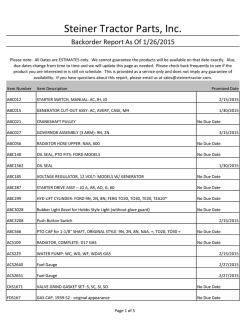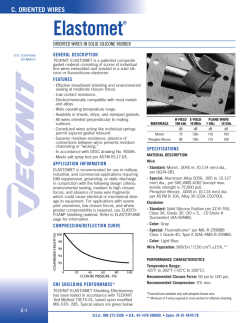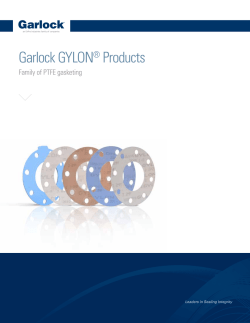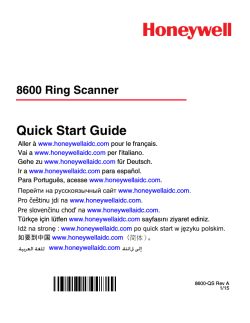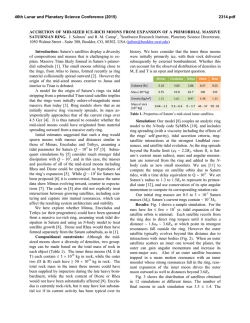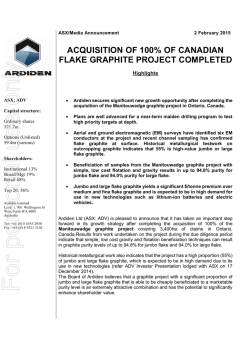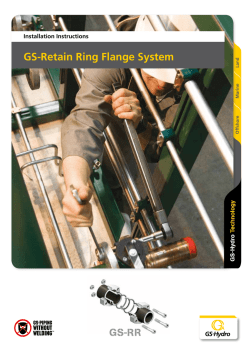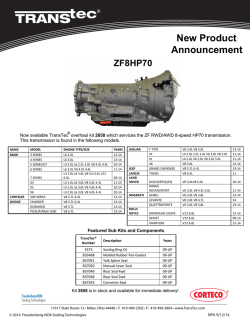
Metallic Gaskets
Metallic Gaskets Creating an effective, safe and sustainable environment exceeding the needs of industry Over the years we have enhanced our technical facilities to develop new products and provide guidance and training programmes for some of the world's largest chemical and petrochemical plants, expanding our operations into the Middle East and Kazakhstan. This brochure outlines our metallic range of products and provides guidelines on their correct selection, storage and assembly. For more information on any of the areas covered please contact our sales or technical team, or visit www.novusproducts.eu. We have a dedicated Research & Development team who ensure high quality technical support for all our products. We constantly look to provide a balanced mix of quality sealing product with a warmth of service. Contents Page Selection Guide 2-3 Camprofile Gaskets 4-7 Corrugated Gaskets 8-9 Spiral Wound Gaskets 10-14 Metal Jacketed Gaskets 15-16 Installation Guide Novus Ring Type Joints 17 18-21 Technical & Testing Services 22 Training for the future 23 Novus Flange Joint Toolkit 24 Novus Select Software Welding and profiling Manufacturing Specification High technology and high performance welding and profiling machines provide quality and integrity through all our metallic product range. The fabrication of metallic products is subject to stringent quality control and test procedures. The specifications for each order are continually checked on every product. Accuracy and precision in every application ensures that quality standards are second to none. Metallic Gaskets 1 Selection Guide Many factors affect the suitability of a gasket in a given application making it difficult to determine which is the correct one for the duty. In heat exchanger applications, factors such as relative flange movement can complicate gasket selection still further and it is important that the attributes of each gasket type are fully understood. Camprofile Gaskets Corrugated Gaskets Spiral Wound Gaskets Metal Jacketed Gaskets Ring Type Joints Camprofile Gaskets consist of a metal core, generally stainless steel, with concentric grooves on either side. A sealing layer is normally applied to both faces and depending on the service the material for this layer can be graphite, PTFE, Novus sheet material, Hi-temp or metal (e.g. aluminium or silver). Camprofile gaskets are ideal for both standard pipe and heat exchanger applications. Corrugated Metal Gaskets consist of a corrugated metal core, normally stainless steel, with a soft facing layer applied to each face. The corrugations provide resilience and reduce the sealing surface area of the gasket while the soft layer ensures outstanding sealing, even at low loads. Particularly suited as a replacement to metal jacketed gaskets. Spiral Wound Gaskets consist of a ‘V’ shaped metal strip spirally wound in combination with a soft filler material, normally graphite, PTFE or Hi-Temp. The metal strip provides outstanding recovery whilst the flexible filler ensures excellent sealing. Depending on the application the gasket can be specified with outer and/or inner rings. Metal Jacketed Gaskets consist of soft filler material encapsulated in a metallic material. The filler material provides the gasket with compressibility and resilience while the jacket confers compressive strength and blow out resistance. Ring Type Joints are designed to concentrate the bolt load over a small area thus producing high seating stresses. As the ring type material should always be softer than the mating flanges, the high seating stress causes ‘plasticflow’ of the ring joint in the flange faces creating the seal. TIGHTNESS EXCELLENT EXCELLENT EXCELLENT AVERAGE EXCELLENT HANDLING EXCELLENT GOOD AVERAGE EXCELLENT EXCELLENT THERMAL CYCLING EXCELLENT EXCELLENT GOOD AVERAGE AVERAGE LOW SEATING STRESS EXCELLENT EXCELLENT AVERAGE AVERAGE AVERAGE HIGH SEATING STRESS EXCELLENT GOOD EXCELLENT GOOD EXCELLENT NARROW FLANGE WIDTH EXCELLENT AVERAGE AVERAGE EXCELLENT AVERAGE EMISSIONS EXCELLENT EXCELLENT EXCELLENT AVERAGE EXCELLENT RECYCLING YES NO NO NO NO To help you make an informed choice on gasket selection the table below lists the advantages and disadvantages of each gasket under various conditions. This table should be used as a general guide for selection only. 2 Metallic Gaskets Metallic Gaskets 3 Camprofile Gaskets Camprofile Gasket Characteristics Camprofile gaskets consist of a metal core, generally stainless steel, with concentric grooves on either side. A sealing layer is usually applied on both sides and depending on the service the material for this layer can be graphite, PTFE (Teflon), Novus sheeting material, Hi-temp or metal (e.g. aluminium or silver). Camprofiles can be used without sealing layers to provide an excellent seal but there is a risk of flange surface damage especially at high seating stresses. The sealing layers protect the flange surface from damage in addition to providing an excellent seal at low bolt stress. Properties Core Thickness Gasket Profiles Camprofiles have a number of properties which make them unique: Core thickness depends on the assembly circumstances. Generally a 3mm core is recommended but for large diameter gaskets above 1.5m it is advisable to use a 4mm core for purposes of stability. All profiles feature as standard a 1mm cam pitch and a maximum groove depth of 0.5mm. Alternative profiles are available on request e.g. 1.5mm cam pitch and a maximum groove depth of 0.75mm (DIN profile). • Highly suitable for varying temperatures and pressures • Less sensitive to assembly faults (inaccurate bolt tightening) • Suitable for light and heavy designed flanges • Dependent upon the layer material camprofile gaskets can resist temperatures up to 1000OC • Resistant to media pressures > 400 bar • When assembled the remaining thickness of the sealing material is extremely low (0.1 - 0.2mm), thus reducing leaks, fail rates and environmental pollution • The gasket will not damage the flange surface and can be easily removed • Camprofile cores are re-usable after cleaning, inspection and relayering with new sealing material. This is of particular interest in the case of heat exchanger gaskets • Reduces maintenance costs and leakage - thanks to camprofile’s high sealing performance and reliability. Seating Stress Range The camprofile gasket offers reliable sealing performance when seated within the following seating stress ranges. The below are based on parallel form gaskets. The values have slight variations for convex forms of camprofiles. SEATING STRESS LAYER MATERIAL MIN (N/mm2) OPT (N/mm2) MAX (N/mm2) GRAPHITE 20 90 400 PTFE 20 90 350 Styles M21LM and M41LM are available in 4mm thickness only due to their construction. CORE THICKNESS (mm) THICKNESS AFTER ASSEMBLY (core + layers) (mm) RECOMMENDED 3 Approx 3.1-3.4 >1.5m M21LM M41LM 4 Approx 4.1-4.4 M18, M20, M21 Advantages of parallel root cores NOVUS SHEET 40 125 200 SILVER 125 240 450 HI-TEMP 40 100 250 Uniform spread of stress at the cams. Uniform spread of stress across the flange surface. M38, M40, M41 Advantages of convex root cores Flange Surface Finish The recommended flange surface finish for camprofiles with sealing layers is from 3.2 to 6.3μm Ra (125-250 RMS), this is also referred to as a smooth finish. Highly suitable for underbolted flanges. Effective seal at low stress. The gasket design ensures a high seating stress area in the centre of the seal face and a lower seating stress towards the outside edges of the seal face. Metallic Gaskets M18L Parallel root core with integral centering ring Profile Selection With or without centering ring Camprofile gaskets with centering rings ensure optimum gasket positioning between the bolts. M20L Parallel root core without centering ring for male/female, tongue/ groove and grooved flanges Loose or integral centering rings Thermal shock conditions may damage camprofiles with integral centering rings (thermal tension may cause cracks in the core). This is prevented by using camprofile gaskets with loose or floating guide rings. M21LM Parallel root core with floating centering ring attached outside the sealing ring The centering rings on styles M21LM and M41LM allow for expansion and contraction without reactionary forces being applied to the core. M38L Convex root core with integral centering ring Optimal gasket performance is ultimately ensured by the quality of flange surface finish and correct assembly. Camprofile Gasket shapes In addition to the round profiles, gaskets can be made in a variety of shapes, oval, rectangular and exchanger with pass bars. Correctly dimensioned gasket drawings are required to make nonstandard gaskets and gasket shapes. 4 GASKET PROFILES M40L Convex root core without centering ring for male/ female, tongue/groove and grooved flanges M41LM Convex root core with floating centering ring, attached outside the sealing ring Metallic Gaskets 5 Camprofile Gaskets Core Material Selection Core Material The core material is generally fabricated in material identical to the piping system to prevent corrosion problems. Camprofile Gaskets M21L and M41L The M21LM and M41LM styles offer the following advantages: During recent years, modified gaskets have been introduced and these are now included in our manufacturing programme. • The floating centering ring is stable and free from expansion stresses Generally camprofile gaskets are manufactured with a 0.5mm thick floating centering ring. Based on intensive research and practical tests, in cooperation with major users, a 1.5mm thick floating centering ring was developed featuring a unique outer edge attachment. Stainless Steel 316L camprofiles cores are generally used with carbon steel pipe systems to prevent gasket corrosion. The recommended camprofile metal cores are shown in the table below. • No distortion of the centering ring by the threads of the bolts, as sometimes occurs in vertical assemblies, causing the camprofile to be positioned eccentrically. This also increases the possibility of re-use, reducing costs • User friendly - the 1.5mm thick guide ring reduces the risk of operator injury during handling • The floating guide ring allows for expansion without applying mechanical stress to the camprofile core. MATERIAL IDENTIFICATION (Trade name) DIN SPECIFICATION DIN MATERIAL NO. B.S. AISA ASTM UNS TEMPERATURE (oC) DENSITY MIN MAX (GR/CM2) LAYER MATERIAL TEMPERATURE (oC) MIN MAX MAXIMUM OPERATING PRESSURE GAS TIGHTNESS APPLICATION Graphite Graphite APX2 PTFE Novus Sheet Silver Hi-Temp Hi-Temp + APX2 -200 -200 -200 -100 -200 -200 -200 400 400 150 100 250 20 100 Good Good Good Good Good Average Good Aggressive Media Aggressive Media Aggressive Media Moderate Media Aggressive Media Gases Gases 450 500 260 250 750 1000 800 Layer Material Selection PTFE The table above may be used to determine the appropriate sealing layer material. We recommend the use of graphite layers for most applications. Only in cases where graphite may cause media contamination, or is not chemically resistant, should an alternative material layer be chosen. PTFE is a high quality synthetic material featuring: • Excellent chemical resistance • Temperature resistant up to 260OC • Good ageing resistance • Excellent gas tightness. Novus Sheet Low Carbon Steel S R St 3.72 - - - -40 500 7.85 Stainless Steel 304 S304 X5 Cr Ni 18 1.4301 304S15/16/13 304 -250 550 7.90 Stainless Steel 304 L S304L X2 Cr Ni 18 9 1.4306 304S11 304L -250 550 7.90 Stainless Steel 309 S309 X15 Cr Ni Si 20 12 1.4828 309S24 309 -100 1000 7.90 Stainless Steel 316 S316 X5 Cr Ni Mo 18 10 1.4401 316S16 316 -100 550 7.90 Stainless Steel 316 L(1) S316L X2 Cr Ni Mo 18 10 1.4404 316S11/13 316L -100 550 7.90 Stainless Steel 316Ti 316Ti X10 Cr Ni Mo Ti 18 10 1.4571 320S31 316Ti -100 550 7.80 Stainless Steel 321 S321 X10 Cr Ni Ti 18 9 1.4541 321S12/49/87 321 -250 550 7.90 Stainless Steel 347 S347 X10 Cr Ni Nb 18 9 1.4550 347S31 347 -250 500 7.90 Stainless Steel 410 S410 X6 Cr 13 1.4000 410S21 410 -20 850 7.80 254SMO 6Mo X1Cr Ni MoCu N 2018 7 1.4547 - S31254 -100 500 8..00 Duplex 2205 X2 Cr Ni Mo N 22 5 3 1.4462 318S13 S31803/32205 -40 300 7.80 Super Duplex 2507 X2 Cr Ni Mo N 25 6 3 1.4410 - S32750 -40 300 7.80 Aluminium AL 1050 A1 99 5 3.0255 1B A91050 -250 300 2.71 Silver Ag - - - - -250 750 10.50 Copper Cu SF - Cu 2.0090 C106 C12200 -250 400 8.90 Nickel 200 Ni200 Ni 99 2 2.4066 3072-76 NA11 N02200 -250 600 8.90 Monel 400 400 Ni Cu 30 Fe 2.4360 3072-76 NA13 N04400 -125 600 8.80 Inconel 600 600 Ni Cr 15 Fe 2.4816 3072-76 NA14 N06600 -100 950 8.40 Inconel 625 625 Ni Cr 22 Mo 9 Mb 2.4856 3072-76 NA21 NO6625 -50 450 8.44 Incoloy 800 800 X10 Ni Cr A1 Ti 3220 1.4876 3072-76 NA15 N08800 -100 850 8.00 Incoloy 825 825 Ni Cr 21 Mo 2.4858 3072-76 NA16 N08825 -100 450 8.14 Hastelloy B2 B2 Ni Mo 28 2.4617 - N10665 -200 450 9.20 Hastelloy C276 C276 Ni Mo 16 Cr 15 W 2.4819 - N10276 -200 450 8.90 Titanium Ti2 Ti 99 8 3.7025 TA2 R50400 -250 350 4.50 Graphite Graphite is a universal, high quality, non asbestos sealing material featuring: • Very good chemical resistance • Resistance to high fluctuating temperatures and pressures • Non ageing properties • Excellent gas tightness qualities. Novus sheet materials consist of synthetic fibre compounds with rubber binders and material fillers. Silver Silver is a precious metal combining excellent gas tightness and chemical resistance properties. Generally used in applications requiring gas tightness at elevated temperatures. Graphite APX 2 Inhibited grade for oxidation resistance. Ideal for use at temperatures above the limit recommended for standard graphite grades. Often used in combination with Novus Hi-Temp for high temperature applications. Hi-Temp Hi-Temp is a mica-based material suitable for high temperature applications, often used in combination with graphite up to temperatures of 800oC. HOWto TOOrder ORDER How Please specify the following when ordering camprofile gaskets. • Style of camprofile gasket • Nominal pipe bore, pressure rating and flange standard • Materials of core and sealing layer • For non standard flanges please specify gasket dimensions. EXAMPLE: The following example illustrates how to order a camprofile gasket (information in bold print is stamped on the centering ring - if present; otherwise the information is printed on the packaging): M41LM – Style M41LM - convex root-form camprofile with floating externally attached centering ring 4”-300lbs – The gasket is suitably dimensioned for 4” flanges, 300lbs pressure rating 316L – Camprofile core of 316L stainless steel Graphite – Graphite sealing layer SALES: To submit an enquiry or place an order, call +44 (0)1274 851273 TECHNICAL HELP: Call our Technical Hotline on +44 (0)1274 851273 (1) Standard Material for Camprofile Gaskets 6 Metallic Gaskets Metallic Gaskets 7 Corrugated Gaskets Corrugated Gasket Characteristics Novus corrugated gaskets comprise a corrugated metallic core, normally stainless steel, with a soft facing layer applied to each face. The corrugations provide resilience and reduce the sealing contact surface area of the gasket while the soft layer ensures outstanding sealing, even at low loads. These gaskets are particularly suited for heat exchanger applications as a replacement to metal jacketed gaskets. Heat Exchanger Applications Properties Seating Stress Range Layer Material Selection PTFE Heat exchanger flanges, owing to the difference in thickness of the mating flanges, heat and expand at different rates. • Excellent resistance to radical shear Corrugated gaskets offer reliable sealing performance when seated within the following seating stress ranges. The table (below) may be used to determine the appropriate sealing layer material. We recommend the use of graphite layers for most applications. Only in cases where graphite may cause media contamination, or is not chemically resistant, should an alternative layer material be chosen. PTFE is a high quality synthetic material featuring excellent chemical resistance, temperature resistant up to 260OC, good ageing resistance 1and excellent gas tightness. This differential expansion can cause radial shearing of the gasket and therefore it is critical that a gasket is selected which resists radial shear and maintains a seal even under thermal cycling conditions. Corrugated metal gaskets have a proven record in problematic exchanger applications, offering low relaxation, high resistance to radial shear and high levels of tightness. For this reason these gaskets are replacing more traditional gasket styles such as metal jacketed particularly on these applications. • Creates a tight seal at low bolt loads • Can be used when there is insufficient bolt load to seal spiral wound gaskets SEATING STRESS (20oC) MINIMUM (N/mm2) OPTIMUM (N/mm2) MAXIMUM (N/mm2) • Outstanding resistance to thermal cycling 20 90 200 • Safe to handle and fit Graphite Thickness • Excellent thermal and chemical stability Available in 1.5mm, 2mm and 3mm. • Tolerant to flange imperfections Flange Surface Finish Practical Benefits • No sharp edges for safe handling • Excellent rigidity ensures easy posting between flanges • Does not stick to flanges The recommended flange surface finish for corrugated gaskets with sealing layers is from 3.2 to 6.3μm Ra (125-250 RMS), this is also referred to as a smooth finish. Sizing Guidelines DIN Sizes 10, 16, 25, 40 bar. ANSI Sizes Class 150 and 300lb. Other sizes available on request. Also available for vessel and non-standard applications. Graphite is a universal, high quality, non asbestos sealing material featuring very good chemical resistance, resistance to high fluctuating temperatures and pressures, non ageing properties plus excellent gas tightness. Graphite APX 2 Inhibited grade for oxidation resistance. Ideal for use at temperatures above the limit recommended for standard graphite grades. Often used in combination with Novus Hi-Temp for high temperature applications. Hi-Temp Hi-Temp is a mica based material suitable for high temperature applications, often used in combination with graphite up to temperatures of 800OC. HOWto TOOrder ORDER How Please specify the following when ordering corrugated gaskets. • Standard of the gasket (flange standard) • Nominal size and pressure class • Materials - core filler EXAMPLE: Chemical Suitability PH Range 0-14. LAYER MATERIAL TEMPERATURE (oC) MIN MAX MAXIMUM OPERATING PRESSURE GAS TIGHTNESS APPLICATION Graphite Graphite APX2 PTFE Hi-Temp + APX2 -200 -200 -200 -200 150 150 50 100 Good Good Good Good Aggressive Media Aggressive Media Aggressive Media Gases 450 500 260 800 Novus CMG Dimensions – ASME B16.20 2” 150lbs SS316 Core Graphite coating layer SALES: To submit an enquiry or place an order, call +44 (0)1274 851273 TECHNICAL HELP: Call our Technical Hotline on +44 (0)1274 851273 8 Metallic Gaskets Metallic Gaskets 9 Spiral Wound Gaskets Spiral Wound Gasket Characteristics The sealing element of the spiral wound gasket consists of a V-shaped metal strip spirally wound in combination with a soft sealing material filler. The metal strip provides outstanding resilience, while the flexible sealing filler guarantees excellent sealing. Due to this combination of materials, the spiral wound gasket is suitable for sealing under severely fluctuating temperature and pressure conditions. Depending on the application the spiral wound gasket can be specified with outer and/or inner rings. 10 Metallic Gaskets Properties Gasket Stress Range • Spiral wound gaskets are suitable for use across a wide gasket stress range. Novus spiral wound gaskets should preferably be mounted within the gasket stress ranges shown in this chart to ensure leak free connections. • Spiral Wound gaskets can be used to seal fluid pressures up to 400 bar and from cryogenic temperatures up to 1000OC. • Spiral Wound gaskets are robust and simple to install. • The outer guide ring simplifies assembly and prevents blowout of the gasket. • By combining different winding materials and metals, the gasket can be tailored to suit a wide variety of operating conditions. Gasket Stress Range: SINGLE SIDE CONFINED FILLER BOTH SIDES CONFINED o GASKET STRESS (20oC) GASKET STRESS (20 C) MIN (N/mm2) OPT (N/mm2) MAX (N/mm2) MIN (N/mm2) OPT (N/mm2) MAX (N/mm2) 50 50 55 95 80 95 180 130 130 50 50 50 120 110 120 400 250 250 Flange Surface Finish The recommended surface roughness of the flange faces, between which a spiral wound gasket is to be mounted, is 3.2 - 6.3μm Ra (125 - 250 RMS), also referred to as smooth finish. Graphite PTFE Hi-Temp + APX2 Standard Gasket Profiles We produce the following types of spiral wound gaskets. • The gasket is easy to remove after service and does not cause any damage to the flange faces. Type RF1 The gasket consists of a sealing filler and V-shaped metal strip wound in combination. This profile is usually applied to tongue/groove flanges. Type SG The standard spiral wound gasket format identical to Novus RF1 but fitted with an outer centering ring (applied to raised face flanges). An integral centering guide ring ensures fast, accurate centering of the gasket on the flange. Provides additional radial strength to prevent gasket blow-out and acts as a compression stop. Type RF-IR Spiral wound gasket for male/female flanges consisting of a wound component fitted with an inner ring to bring the gasket flush with the pipe bore to prevent inward buckling. Type SG-RTJ A standard spiral wound gasket (SG Type) with dimensions tailored to Ring Joints (RTJ) flanges. Type HX-R This type of gasket consists of a wound component fitted with a narrow wound centering ring. Centering windings ensure correct centering in flush flanges (e.g. in heat exchangers). Type HX-RIR This gasket is identical to HX-R but also fitted with an inner ring, rendering this gasket type suitable for mounting in male and female flanges. Type SG-IR Identical to Novus SG but also fitted with an inner ring to prevent inward buckling at the windings. Metallic Gaskets 11 Spiral Wound Gaskets Special Profiles Profile with a GT - Zone In the event of a graphite filled spiral wound gasket possibly causing an undesirable reaction between the graphite and the medium to be sealed, or of possible medium contamination, the problem can be solved by using a spiral wound gasket with a GT - Zone. Special Shapes Type WL Spiral wound gaskets can be produced in a wide variety of shapes, such as oval and pear-shape, with pass partition bars and many other types. Generally, the pass partition bars on spiral wound gaskets are manufactured as metal-jacketed bars. A variety of alternatives are available. This gasket is identical to RF1 but fitted with an outer winding. Centering is achieved by positioning the winding over two bolts opposite each other. Type MH This spiral wound gasket is identical to the RF1 profile but oval shaped to fit manholes. Type TC/HH The spiral wound element of a Novus GT - Zone gasket consists of outer windings of Hi-Temp material with a central winding zone made of graphite or PTFE (depending on the operating conditions) to improve gas tightness. This results in a spiral wound gasket with the following properties: • Can be used at higher temperatures • Has excellent sealing properties Combined with the other advantages of a spiral wound gasket, the spiral wound with a GT - Zone may be used in a wide range of operating conditions and applications. This type of gasket is for hand holes and special flange assemblies (tube cap and hand hole covers). They are available in square, rectangular, oval, diamond and pear shapes. A drawing specifying the correct dimensions are required to manufacture special shapes. Outer Winding Guide Rings and Material Selection Benefits of the Centering Ring The spiral wound gasket outer centering ring provides the following benefits: • Optimum location between the bolts • Protection of the spiral wound element • Additional security against gasket blow-out Bolt Position Spiral Gasket Type HE Fitted with pass partition bars for use on heat exchangers and vessels, this gasket type is otherwise identical to the RF1 profile. Metal - jacketed bars have a thinner design than that of spiral wound gasket material. • Acts as compression limiter preventing overloading and over compression of the spiral wound element • Prevents radial-flow of soft fillers, 1such as PTFE. For these reasons it is preferable to use spiral wound gaskets with outer centering rings. The outer ring is marked with nominal size, pressure class, standard and materials. MATERIAL IDENTIFICATION (TRADE NAME) The bars are fixed through welding. Type HE-SG Fitted with an outer centering ring, the HE-SG is otherwise identical to the HE profile. Type HE/SG-IR Fitted with an outer centering ring and an inner ring, the HE/SG-IR is otherwise identical to the HE profile. Benefits of the Inner Ring Material Selection The spiral gasket inner ring provides the following benefits: The material selected for the inner ring and winding metal is usually the same as the flange metal. This prevents corrosion and differential expansion problems. The outer centering ring is generally manufactured from carbon steel with an anti- corrosion treatment. However, the ring may also be manufactured in the same metal as the flange to prevent corrosion problems. • Prevents radial-flow of soft fillers, such as PTFE + Graphite • Reduces turbulence-minimising flow resistance • Acts as a heat shield when the spiral wound gasket is subjected to high temperatures. Inner and outer rings are particularly recommended for use on spiral wound gaskets exceeding class 600lbs, but specifically recommended for high temperatures and pressures to optimise the operational reliability of the spiral wound sealing element. Inner rings are mandatory for PTFE filled spirals. DIN SPECIFICATION DIN MATERAIL NO. B.S. The table below lists the application limits and specifications of alloys used in the manufacture of spiral wound gaskets. AISA ASTM UNS TEMPERATURE (oC) MIN MAX DENSITY (GR/CM2) Low Carbon Steel S R St 3.72 - - - -40 500 7.85 Stainless Steel 304 S304 X5 Cr Ni 18 1.4301 304S15/16/13 304 -250 550 7.90 Stainless Steel 304 L S304L X2 Cr Ni 18 9 1.4306 304S11 304L -250 550 7.90 Stainless Steel 309 S309 X15 Cr Ni Si 20 12 1.4828 309S24 309 -100 1000 7.90 Stainless Steel 316 S316 X5 Cr Ni Mo 18 10 1.4401 316S16 316 -100 550 7.90 Stainless Steel 316 L(1) S316L X2 Cr Ni Mo 18 10 1.4404 316S11/13 316L -100 550 7.90 Stainless Steel 316Ti 316Ti X10 Cr Ni Mo Ti 18 10 1.4571 320S31 316Ti -100 550 7.80 Stainless Steel 321 S321 X10 Cr Ni Ti 18 9 1.4541 321S12/49/87 321 -250 550 7.90 Stainless Steel 347 S347 X10 Cr Ni Nb 18 9 1.4550 347S31 347 -250 500 7.90 Stainless Steel 410 S410 X6 Cr 13 1.4000 410S21 410 -20 850 7.80 254SMO 6Mo X1Cr Ni MoCu N 2018 7 1.4547 - S31254 -100 500 8.00 Duplex 2205 X2 Cr Ni Mo N 22 5 3 1.4462 318S13 S31803/32205 -40 300 7.80 Super Duplex 2507 X2 Cr Ni Mo N 25 6 3 1.4410 - S32750 -40 300 7.80 Aluminium AL 1050 A1 99 5 3.0255 1B A91050 -250 300 2.71 Nickel 200 Ni200 Ni 99 2 2.4066 3072-76 NA11 N02200 -250 600 8.90 Monel 400 400 Ni Cu 30 Fe 2.4360 3072-76 NA13 N04400 -125 600 8.80 Inconel 600 600 Ni Cr 15 Fe 2.4816 3072-76 NA14 N06600 -100 950 8.40 Inconel 625 625 Ni Cr 22 Mo 9 Mb 2.4856 3072-76 NA21 NO6625 -50 450 8.44 Incoloy 800 800 X10 Ni Cr A1 Ti 3220 1.4876 3072-76 NA15 N08800 -100 850 8.00 Incoloy 825 825 Ni Cr 21 Mo 2.4858 3072-76 NA16 N08825 -100 450 8.14 Hastelloy B2 B2 Ni Mo 28 2.4617 - N10665 -200 450 9.20 Hastelloy C276 C276 Ni Mo 16 Cr 15 W 2.4819 - N10276 -200 450 8.90 Titanium Ti2 Ti 99 8 3.7025 TA2 R50400 -250 350 4.50 Standard Material for Spiral Wound Windings 12 Metallic Gaskets Metallic Gaskets 13 Spiral Wound Gaskets Filler Material Selection The table opposite may be used to select the correct filler. It should be pointed out that graphite will be the optimum filler in most cases. Only where graphite could cause media contamination, or is not chemically resistant, should the use of another type of filler material be recommended. In such cases, an alternative solution might be to select a gasket with a GT-zone. Metal Jacketed Gaskets Standard Fillers Metal Jacketed Gasket Characteristics LAYER MATERIAL TEMPERATURE (oC) MIN MAX MAXIMUM OPERATING PRESSURE (BAR) GAS TIGHTNESS APPLICATION Graphite Graphite APX2 PTFE Hi-Temp Hi-Temp + APX2 -200 -200 -200 -200 -200 400 400 150 5 100 Good Good Good Average Good Aggressive Media Aggressive Media Aggressive Media Gases Gases 450 500 260 1000 800 Non standard materials are available on request Graphite Graphite is universally chosen because of its good chemical resistance, resistance to ageing, good gas tightness and ability to operate at high temperatures. APX2 APX2 is an oxidation resistant graphite which offers the same excellent sealing characteristics of graphite but can be used at higher service temperatures. PTFE PTFE is a high quality synthetic material with the following characteristics: excellent chemical resistance, resistance to 260OC, resistant to ageing, excellent gas tightness. Hi-Temp Hi-Temp is mica based material suitable for high temperature applications, often used in combination with graphite (GT-zone). HOWto TOOrder ORDER How Please specify the following when ordering Spiral Wound Gaskets. • Type of Spiral wound gasket required • Standard of the gasket (flange standard) • Nominal size and pressure class • Material: - Inner ring - Metal winding - Filler - Outer ring EXAMPLE: Metal jacketed gaskets consist of a metal cover and a ‘soft’ sealing material filler. The sealing filler provides outstanding resilience, while the metal jacket guarantees good sealing and protects the filler against pressure conditions, fluctuating temperatures and corrosion. A wide variety of materials are available to guarantee satisfactory sealing. The metals listed on the next page are standard, other metals are available on request. This type of gasket is being replaced by either Camprofiles (see pages 4-7) or corrugated metal products (see pages 8-9). Welded Metal Jacketed Gaskets Welded metal jacketed gaskets are manufactured in a wide range of sizes and styles. Generally they are used in Heat Exchangers, Vessels, Pumps, Autoclaves, Engines, Valves, and Exhaust Systems. Metal jacketed gaskets require machined flange faces, high bolt loads and exact flange alignment to ensure an effective seal. It is for this reason that we recommend the use of Camprofile or Corrugated Metal Gaskets for most applications. One-piece Welded bar metal jacketed gaskets offer the following benefits over one-piece gaskets with integral bars: • Lower price - Typical cost savings 10% to 40% (depending on material) Welded • Quicker delivery - Less time to manufacture • Technically superior and safer - Extra sealing safeguards give a better gasket • Longer sealing life - Bars seal independently of the outer ring. Novus SG-IR Dimensions – ASME B16.20 2” 150lbs SS316L SS316L Graphite Carbon Steel SALES: To submit an enquiry or place an order, call +44 (0)1274 851273 TECHNICAL HELP: Call our Technical Hotline on +44 (0)1274 851273 14 Metallic Gaskets Metallic Gaskets 15 Metal Jacketed Gaskets Type S6 Seating Stress Gasket Profiles Metal jacketed gaskets can be produced in a variety of styles. The diagram below shows the standard range of shapes for vessels and heat exchangers. Flange Surface Finish We recommend a maximum flange surface finish of 1.6μm. MINIMUM (N/mm2) OPTIMUM (N/mm2) MAXIMUM (N/mm2) 80 110 180 Filler materials: Non Asbestos Millboard S2 S3 S4 S4A A I Q B J R Standard Vessel and Heat Exchanger Profiles The illustrations opposite represent standard Novus spiral wound gasket shapes for vessel and heat exchanger flanges. Standard Metals Profiles Stainless Steel Aluminium Copper Brass Titanium Silver Carbon Steel Soft Iron Monel Inconel Incoloy Nickel Hastelloy Standard Vessel & Heat Exchanger Profiles SEATING STRESS (20oC) When ordering metal jacketed gaskets with pass-partition bars, a drawing with the exact dimensions and positions is required. Jacket material: Installation Guide Aluminium Copper Stainless Steel Monel Nickel Hastelloy Soft Iron Brass Inconel Incoloy Silver Titanium C Standard Fillers S7 PTFE Non-asbestos Millboard Graphite S D E G L M N O T U V W S8 PTFE Uniflon H S9 P X Graphite S12 HOWto TOOrder ORDER How Please specify the following when ordering metal jacketed gaskets. • Material - Jacket and Filler • Type of metal jacketed gasket required Novus Metal Jacketed Type S6 Dimensions: ASME B16.20 2” 150lbs SS316, Non-asbestos Millboard • Standard of the gasket (flange standard) EXAMPLE: Gasket Bolting • Always use a new gasket In order to ensure the optimum service life of Novus metallic gasket materials it is not only important to choose the correct material for the application but to install and maintain it correctly. • Check that the gasket is in good condition and that the dimensions are correct for the class and size of the flanges • Ensure the bolt and nut threads are clean. Apply bolt lubrication to the bolt and nut threads and to the face of the nut to be tightened. Do not apply grease or bolt lubricant to the joint face. After cleaning and lubrication it should be possible to run the nut along the full length of the bolt by hand. If this is not possible the bolts and nuts should be refurbished or replaced The following guidelines are designed to assist the end user in the assembly of Novus gasket materials. Flange Condition F S6 K Installation of Novus Metallic Gaskets SALES: To submit an enquiry or place an order, call +44 (0)1274 851273 TECHNICAL HELP: Call our Technical Hotline on +44 (0)1274 851273 • Remove the old gasket and check that the flange faces are clean and free from indentations and scoring. Radial (cross face) scoring is a particular concern and can lead to joint leakage • For camprofiles, corrugated metal and spiral wound gaskets, a surface finish of between 3.2μm to 6.3μm Ra (125 to 250 micro inch) is recommended; for metal ring joints a surface finish of between 0.8μm and 1.6μm is recommended (dependent on style) and for metal jacketed gaskets a surface finish of 1.6μm Ra is recommended. Use a surface finish comparator e.g. Novus comparator to check flange finish (right). • Check that the flange faces are parallel or that the pipework is sufficiently flexible to allow the flanges to be pulled parallel and concentric without excessive bolt loads. • Do not use jointing compounds, grease or lubricants with Novus metallic gasket materials. These compounds can affect the contact friction between the gasket and the flange and can lead to creep and premature joint failure • If there is a requirement to fix the gasket to the flange prior to assembly (e.g. large vertical flanges) then a light dusting of spray adhesive e.g. 3M 77 spray may be used. The adhesive should be applied sparingly and in isolated areas, and must be compatible with the fluid medium. • Scrape, wire brush or file as necessary the back face of each flange where the bolt heads and nuts are to sit, ensuring that the surfaces are clean and flat • If possible use hardened flat washers to ensure even transfer of the load. Installation • Ensure that the gasket is installed centrally • It is recommended that the bolts are tightened using a controlled method such as torque or tension. If using a torque wrench, ensure that it is accurately calibrated • Tighten bolts in a star-like crossing pattern in the following sequence • Finger tighten nuts • Tighten to 30% of the final load • Tighten to 60% of the final load • Tighten to full load • Make a final tightening sequence, working around the flange, tightening each bolt in turn until the specified torque is achieved. After Installation Check that the flange faces are parallel using a suitable tool e.g. Novus Flange Gap Tool (below). • Nominal size and pressure class 16 Metallic Gaskets Metallic Gaskets 17 Novus Ring Type Joints Ring Type Joints Ring Type Joint Profiles Ring type joints are designed to concentrate the bolt load over a small area thus producing high seating stresses. As the ring type material should always be softer than the mating flanges, the high seating stress causes ‘plastic-flow’ of the ring joint in the flange faces creating the seal. Type R Ring Type Joints Type BX Ring Type Joints M11 Type RX Ring Type Joints We suppy a range of specialised Ring Type Joints for critical and non standard applications to suit the requirements of the petrochemical industry. RX Ring Type Joint M12 Novus model M12PI M8 M9 Novus models M8 and M9 M8 model R oval section and M9 model R octagonal section ring type joints are designed for flanges with standard ring type grooves. These standard shapes are used to seal pressures up to 5,000 psi in accordance with API 6A. The octagonal cross section has a higher sealing efficiency than the oval cross section and is therefore preferred. The oval section ring joints were originally designed for the now obsolete round bottom groove. Both the oval and the octagonal cross section are interchangeable on the flat bottom groove design. PTFE Insert Novus model M11/M11S Novus model M12/M12S Cam-ORJ M11 model BX ring type joints are designed for pressures up to 20,000 psi, suitable only for use with API type BX flanges and grooves. M12 model RX ring type joints are designed for pressures up to 5,000 psi. The Cam-ORJ is a standard API 6A octagonal ring joint but with the four angled seating surfaces concentrically serrated and faced with oxidation inhibited graphite. The gasket offers the high sealing efficiency associated with the octagonal design but with the added benefit of being capable of sealing flanges with minor damage. Under compression the graphite flows into minor imperfections creating a tight seal. The gasket has a square cross section with bevelled corners. The average diameter of the ring joint is slightly greater than that of the flange groove. This way, when the ring joint is seated, it stays pre-compressed by the outside diameter, creating high seating stress. The M11S Model SBX ring type joint is the same design as the BX ring, however the suffix ‘S’ indicates that additional pressure equalisation holes have been drilled in accordance with API 17D for use on sub sea wellhead and christmas tree equipment. A pressure activated ring joint, its shape is designed so that the fluid pressure increases sealability. The outside sealing surface of the ring joint makes the initial contact with the flange. As the internal pressure rises the contact pressure between ring joint and flange also increases. This is sometimes referred to as a pressure activated ring joint. due to the shape of the gasket. High seating pressures are created increasing the sealability. This design characteristic makes the RX ring joint more resistant to vibrations, pressure surges and shocks that occur during oil well drilling. M12S Model SBX ring type joint is the same in design to the RX ring, however, the suffix ‘S’ indicates that additional pressure equalisation holes have been drilled in accordance with API 17D for use on sub sea wellhead and christmas tree equipment. The Cam-ORJ is available in a range of Alloy materials and in sizing to suit ASME B16.5 or API 6A flanges. Novus model M8R and M9R Rubber Coated Ring Type Joints This is an octagonal/oval section ring type joint generally soft iron or low carbon steel totally enclosed in a nitrile rubber coating. Widely used in pressure testing procedures, minimising any damage to the flange. Ring Type Joints with PTFE Inserts M12 model RX ring type joints can be supplied with PTFE inserts. Designed to reduce turbulent flow and eliminate ring joint and flange corrosion. The insert is specially designed with radially drilled holes ensuring the self-energising performance is not affected. The insert is located between the inside diameter of the ring joint and the bore of the flange. On assembly, the insert is captured between the flanges, filling the void between ring joint and flange bore. Blind Ring Type Joints These specialised ring type joints are designed and manufactured for the customer who has a requirement to blank off flanges and pipe work. The joints are standard rings but with a machined metallic centre. Blind ring type joints can be supplied in a variety of materials. (Continued on page 20) 18 Metallic Gaskets Metallic Gaskets 19 Novus Ring Type Joints Ring Type Joint Profiles Seating Stress Hardness of Ring Type Joint Materials SEATING STRESS (20oC) Combination Ring Type Joints This ring type joint consists of two different sizes having the same pitch diameter, used for sealing and flange joint where the mating flanges have different ring groove dimensions or profiles. These ring type joints can be produced with either octagonal or oval facings, however they are not manufactured in accordance with API specification. MATERIAL IDENTIFICATION MINIMUM (N/mm2) OPTIMUM (N/mm2) MAXIMUM (N/mm2) Soft Iron Low Carbon Steel A182FS SS304 SS316 SS321 SS347 D S FS S304 S316 S321 S347 235 265 400 335 335 335 335 350 400 600 500 500 500 500 525 600 900 750 750 750 750 To achieve a reliable seal, the ring type joint should be assembled within the seating stress parameters shown in the table above. Lens Rings This is a contact seal for use in high pressure piping systems and in pressure vessel heads. Lens rings have a spherical surface that requires special matching of the flanges. Effective sealing is obtained at relatively low bolt loads. These ring type joints are manufactured in accordance with DIN 2696. For enquiries complete drawings must be supplied. Flange Surface Finish The ring type joint and the sealing face of the groove must be free of indentations, score marks, tool and chatter marks. The maximum flange surface finish for M8, M9, model R, M12 model RX is 1.6μm RA (63RMS). The maximum flange surface finish for M11 model BX is 0.8μm RA (32RMS). As with the Lens rings, all enquiries and orders should be sent with complete drawings. 20 Metallic Gaskets MATERIAL IDENTIFI -CATION DIN SPECIFICATION DIN MATERIAL NO. B.S. Soft Iron D - - - Low Carbon Steel S R st 37.2 - - F5 FS 5 Cr 0.5 mo 1.7362 SS304 S304 X5Cr Ni 18 SS304L S304L SS309 S309 Please specify the following when ordering Novus ring type joints. SS316 • Ring type joint model AISA-ASTM UNS MAXIMUM HARDNESS TEMPERATURE (oC) DENSITY (GR/CM2) BRINELL HB ROCKWELL B MIN HRB MAX - 90 56 -40 500 7.85 - 120 68 -40 500 7.85 - A182FS 130 72 -40 650 7.83 1.4301 304S15/16/13 304 160 83 -250 550 7.83 X2 Cr Ni 18.9 1.4306 304S11 304L 160 83 -250 550 7.90 X15 Cr Ni Si 20.12 1.4828 304S24 309 160 83 -100 1000 7.90 S316 X5 Cr Ni Mo 18.10 1.4401 316S16 316 160 83 -100 550 7.90 SS316L S316L X2 Cr Ni Mo 18.10 1.4404 316S11/13 316L 160 83 -100 550 7.90 SS316Ti S316Ti X10 Cr Ni Mo Ti 18.10 1.4571 320S31 316Ti 160 83 -100 550 7.80 SS321 S321 X10 Cr Ni Ti 18.9 1.4541 321S12/49/87 321 160 83 -250 550 7.90 • Ring number/size & pressure rating SS347 S347 X10 Cr Ni Nb 18.9 1.4550 347S31 347 160 83 -250 500 7.90 SS410 S410 X6 Cr 13 1.4000 410S21 410 170 86 -20 850 7.80 • Material/identification 254SMO 6Mo X1Cr Ni Mo Cu N20.18.7 1.4547 - S31254 180 89 -100 500 8.00 • Flange standard Duplex 2205 X2 Cr Ni Mo N 22.5.3 14462 31853 S31803/32205 230 approx 99 -40 300 7.80 Super Duplex 2507 X2 Cr Ni Mo N 25.6.3 14410 - S32750 230 approx 99 -40 300 7.80 EXAMPLE: Aluminium AL 1050 A1 99.5 3.0255 1B A91050 30 - -250 300 2.71 M8 R Oval R16/Class 1” 3/600lbs Soft Iron or D ASME/ANSI B16.5 Silver Ag - - - - 28 (HV) - -250 750 10.50 Copper Cu SF-Cu 2.0090 C106 C12200 80 approx - -250 400 8.90 Brass CuZn37 Cu Za 37 (M563) 20321 CZ108 C27200 60 approx - -100 350 8.50 Nickel 200 Ni 200 Ni 99.2 2.4066 3072-76 NA11 NO2200 110 62 -250 600 8.90 Monel 400 400 Ni Cu 30 Fe 2.4360 3072-76 NA13 NO4400 150 80 -125 600 8.80 Note: This can be abbreviated to R16D Oval RTJ Inconel 600 600 Ni Cu 15 Fe 2.4816 3072-76 NA14 NO6600 150 80 -100 950 8.40 Inconel 625 625 Ni Cr 22 Mo 9 Mb 2.4856 3072-76 NA21 NO6625 150 80 -50 450 8.44 Incoloy 800 800 X10 Ni Cr A1 Ti 3220 1.4876 3072-76 NA15 NO8800 150 80 -100 850 8.00 Incoloy 825 825 Ni Cr 21 Mo 2.4858 3072-76 NA16 NO8825 195 92 -100 450 8.14 Hastelloy B2 B2 Ni Mo 28 2.4617 - N10665 230 99 -200 450 9.20 Hastelloy C276 C276 Ni Mo 16 Cr 15 W 2.4819 - N10276 210 95 -200 450 8.90 Titanium Ti2 Ti 99 8 3.7025 TA2 R50400 215 approx 96 -250 350 4.50 HOW TO ORDER Delta Rings This is a pressure actuated ring used primarily on pressure vessels and valve bonnets at pressures in excess of 5000 psi. Internal pressure forces the delta ring material to expand. This table provides comparative data of ring type joint material hardness values. (TRADE NAME) For other materials please contact our technical department Seating Stress On installation, the material of the ring joint has to be softer than that of the flange to avoid damage. SALES: To submit an enquiry or place an order, call +44 (0)1274 851273 TECHNICAL HELP: Call our Technical Hotline on +44 (0)1274 851273 * Brinell hardness measured with 3000kg, and 10mm diameter hardened steel ball. Softer materials i.e. copper & brass are measured with 500kgs and 10mm diameter hardened steel ball. * Rockwell B hardness is measured with 100kg and 1.60mm diameter steel ball. Metallic Gaskets 21 Technical & testing services Technical Support Our product and service offering is underpinned by high quality technical support from a team of engineers acknowledged as one of the most experienced, knowledgeable and customer-focused in our industry. We are active members of the European Sealing Association and our engineers contribute to international technical committees including ASME and European standards organisations. The knowledge and experience of our technical team allows us to provide rapid response to customer enquiries as well as provide innovative and practical solutions to even the most problematic sealing application. Training for the future Our engineers are available 24/7 to assist you with: Our testing capability extends across all industries and includes: • Product recommendations • Joint design and calculations • High temperature and pressure service • Installation guidance • Heat exchangers • On-site support • Compressors • Innovative software solutions • Aerospace engines • Failure analysis and solutions • Valve and pump testing Testing Service We have dedicated test facilities for the development of new products, the control of quality and the solving of application problems. The range and breadth of equipment places the company at the forefront of sealing technology. Our facilities allow us to replicate the conditions under which a flanged joint operates in service. The data gathered can be used to ensure that the most suitable gasket is being employed and that it is properly loaded to withstand the operating conditions. Training Courses Location Benefits The Academy of Joint Integrity offers Accredited and Awareness Training Courses to all personnel who are actively involved in the assembly and tightening of flanged bolted connections. Mentoring and assessment programmes complement the training provision. All training courses will be delivered by industry professionals with current and relevant experience in the field. The Academy has dedicated facilities in Aberdeen, Teesside, Humberside and West Yorkshire. • Legislation compliance The Academy is a member of the Energy Institute and has contributed to the latest UK Oil and Gas best practice guidelines, specific to Joint Integrity Management. The Academy is also an active member of an ASME sub-committee, developing new initiatives for Pressure Boundary Bolted Flange Joint Assembly. Training is also offered within our overseas operations. Courses Training can be delivered in a variety of ways: • At the clients premises, utilising mobile training rigs and equipment • At the Academy, utilising our purpose built training centres • Via ‘Blended Training’ using a web based learning portal with a unique E-Learning programme. • Motivated workforce with best practice skills • Reduced costs with increased asset integrity • Access to the latest technical standards and procedures • Sealing and integrity modules providing greater knowledge • Alliance and structured support from a world class technical / training team. For further information on the range of courses available, visit www.academyofjointintegrity.com Academy training courses incorporate Energy Institute, European (EN1591 part 4) and ASME PCC-1-2010 methods and procedures. “ We offer exceptional technical support from a team of engineers acknowledged as one of the most experienced, knowledgeable and customer-focused in the industry. 22 Metallic Gaskets Petrochemical industry operations and maintenance involve many complex and potentially hazardous activities, and it is imperative that the industry can develop and demonstrate the competence of personnel involved in this work. The focused training and verification provided by The Academy of Joint Integrity courses delivers a reliable and comprehensive solution, allowing operating companies to assure the competence of personnel and supporting the overall integrity management ambition. Dr Kevin McQuillan Special Projects Director SABIC Manufacturing ” Metallic Gaskets 23 NOVUS SEALING OVERSEAS OPERATIONS Novus Sealing Pty Ltd 15 Vinnicombe Drive Canning Vale Perth Western Australia 6155 T: + 61 (08) 9455 2155 F: + 61 (08) 9455 2165 E: [email protected] www.novussealing.com.au Novus Sealing Technology (Shanghai) Co. Ltd Bld 1, No. 1069, Xuanzhen (E) Road Nanhui Industrial Park Shanghai P.R. China T: + 86 (0) 21 6608 0973 F: + 86 (0) 21 6608 0977 E: [email protected] www.novussealing.com.cn www.novusproducts.eu Novus Sealing SA 15 Coert Steynberg Street Van Eck Park – Extension 2 Brakpan, Gauteng South Africa T: + 27 (0) 11 915 0016 F: + 27 (0) 11 915 0940 E: [email protected] www.novussealing.co.za Novus Sealing Caspian LLP 7v Atambayev Street Atyrau, 060005, Republic of Kazakhstan T: + 7(7122) 251103 F: + 7(7122) 252835 E: [email protected] www.novussealingcaspian.com Novus Sealing Middle East LLC PO Box 6591, Al Jazeera Warehouse WIZ04-30 & 32 Al Hamra Warehouse Area Ras Al Khaimah United Arab Emirates T: + 971 (0)7 243 4305 F: + 971 (0) 7 243 4306 E: [email protected] www.novussealing.ae Novus Sealing (M) SDN BHD Plo 232 Kawasan Perindustrian Tebrau III 81100 Johor Bahru Johor Darul Takzim Malaysia T: + 607 351 3910 F: + 607 357 9910 E: [email protected] www.novusealing.my Novus Sealing Nigeria Ltd Plot 29A, Elelenwo Street GRA Phase 1, Port Harcourt Rivers State Nigeria T: + 234 (0) 84 901022 E: [email protected] www.novussealing.com.ng Designed & produced by Clear Design (Scotland) Ltd. www.clearwebsite.co.uk Jan 2013 - Rev 2 UK OFFICE Flexitallic Ltd Scandinavia Mill Hunsworth Lane Cleckheaton West Yorkshire BD19 4LN England, UK T: + 44 (0)1274 851273 F: + 44 (0)1274 300303 E: [email protected] www.flexitallic.eu
© Copyright 2025
